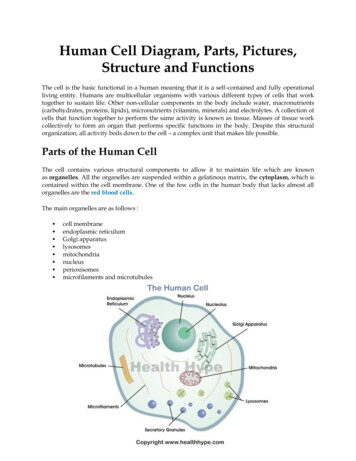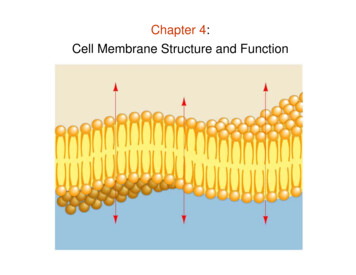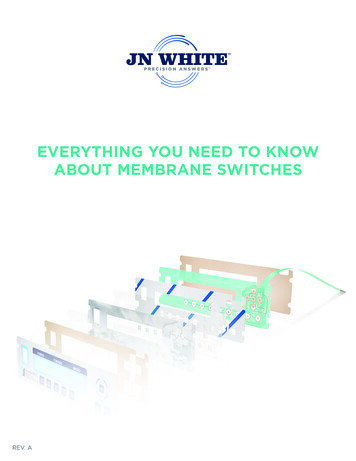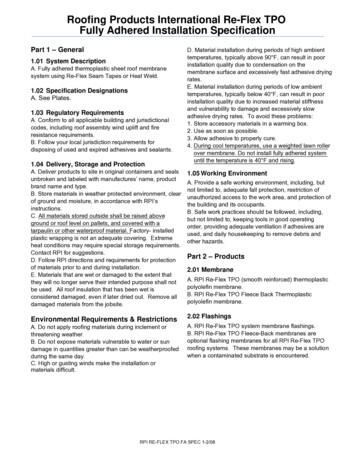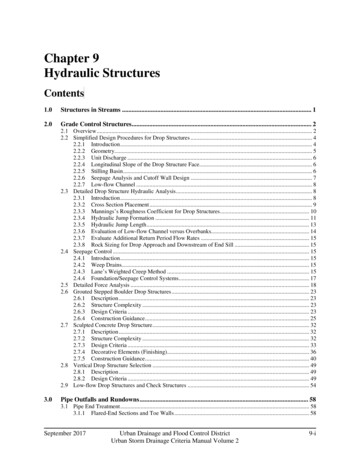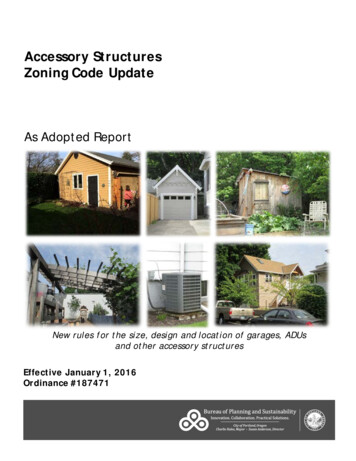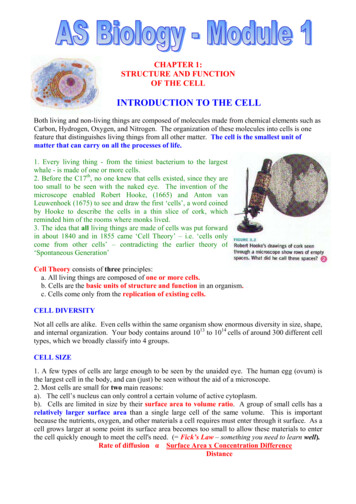
Transcription
Multi-Layered Membrane Structures with Curved Creases forSmooth Packaging and DeploymentNicolas Lee and Sergio Pellegrino†California Institute of Technology, Pasadena, CA 91125We present a design for a deployable multi-layered membrane structure that uses a curved crease patternto enable smooth wrapping around a spool. The crease pattern is parameterized to enable a variety of designs,and a specific implementation was selected based on an existing patch antenna array design. We constructed aprototype structure based on this geometry, and conducted deployment tests to measure the deployment forceprofile required to unfold the structure and to unwrap it from a spool. We find that the deployment forcefor unwrapping is significantly higher than for unfolding. These force profiles are repeatable over multipledeployments and the global trends do not depend on deployment rates over the range tested, between 1 and8 mm/s. However, the local dynamic behavior can depend on deployment rate.I.IntroductionIn this paper, we present a design for a multi-layered membrane structure that can be deployed from a cylindrical spool. This type of deployable membrane structure has potential applications in spacecraft systems. Deployablesystems in general are a crucial aspect of spacecraft design because of their ability to address and satisfy constraintsimposed during different mission phases. During launch, the rocket fairing and the acoustic environment impose geometric and stiffness constraints that are often incompatible with the performance requirements for large area systemsduring the operational phase. Maximizing the area of a spacecraft component is essential for many systems whereperformance is directly related to a captured flux quantity. Obvious examples include solar arrays and communications antennas, but deployed area is also a factor for systems including but not limited to telescopes, radar, and in situdust detectors and collectors. While many spacecraft use deployable technology, it remains a significant risk with ahistory of many failures and anomalies. These include jammed solar panel hinges (e.g. Intelsat 191 ) and dish antennas(e.g. Galileo’s high gain antenna2 and SkyTerra 1’s 22-meter L-band antenna3 ), incomplete tether deployments (e.g.MAST4 ), and broken tethers and booms (e.g. ARTEMIS, TSS-1R5 ). Membrane systems in particular are prone tounexpected behavior during deployment, including for example the tearing of the Znamya 2.5 solar reflector,6 andpremature expansion of components of the Inflatable Antenna Experiment.7 The dependence of future spacecrafton deployable systems necessitates a better understanding of their behavior through all mission phases in order tocharacterize and reduce overall mission risk.Deployable spacecraft systems can range from extremely lightweight, such as solar sails that use membranes onlyseveral microns thick, to relatively thick rigid panels such as the solar arrays deployed on communications satellites.For some applications, the rigidity of a panel is not required and the complexity of hinges undesirable. In somecases, like proposed large radar arrays for Earth observation, discrete panels are too heavy to be feasible but the thinmembranes used in solar sails are too thin to support the electronic components associated with each antenna.In this paper, we present a design for a deployable thick-membrane structure for applications that require anintermediate solution between thin membranes and rigid panels, using a membrane that is thick enough to supportelectronics but is thin enough to be flexible. In particular, we focus on the implementation of a planar structure thatis compatible with an existing design for a membrane patch antenna array for synthetic aperture radar (SAR), asillustrated in Figure 1. This structure is composed of two parallel membrane surfaces joined to each other by a set ofribs that determine the thickness of the structure. The membranes are creased using a curved design to enable tightpackaging around a hub such that the structure can be packaged for launch into a volume with dimensions smaller W. M. Keck Institute for Space Studies Postdoctoral Scholar, Graduate Aerospace Laboratories, 1200 E. California Blvd. MC 301-46.nnlee@caltech.edu† Joyce and Kent Kresa Professor of Aeronautics and Professor of Civil Engineering, Graduate Aerospace Laboratories, 1200 E. California Blvd.MC 301-46. AIAA Fellow. sergiop@caltech.edu1 of 20American Institute of Aeronautics and Astronautics
Figure 1. Rendering of a 6U CubeSat concept with membrane antenna array. In this image, the membrane antenna is shown with 16patch antenna elements and is supported by a longitudinal boom. The membrane would theoretically deploy out of a 3U volume, with thespacecraft bus occupying the other 3U. Background image courtesy NASA.than the length of an uncreased panel. The full structure is 29.2 cm in width and 124.8 cm in length, with a 1.27 cmseparation between the two layers. A full-size prototype structure was constructed (Figure 2) and used to conductdeployment experiments.Through these experiments, we found that the dominant force resisting deployment as the structure is unfoldingresults primarily from the unwrapping of the membrane from a hub, but that this deployment force can be exceededby the tension required at the end of deployment to ensure that the structure is adequately flat. The measured forceprofiles were repeatable over multiple deployments and the global trends did not appear to depend on deployment ratesover the range tested, between 1 and 8 mm/s. We also found that the deployment rate can affect the dynamic behaviorof the membrane, even at relatively low rates.Section II provides an overview of relevant background to the work described in this paper. Section III describesmathematically the crease pattern used to enable smooth wrapping of the folded structure on a cylindrical hub, including a general derivation for a parameterized structure with arbitrary dimensions and a specific design for the antennaarray configuration. Section IV presents the techniques used to assemble a prototype membrane structure consistentwith the geometry of the design from Section III. Deployment experiments that characterize the force profile using theprototype in a materials testing machine are described in Section V, with results presented and discussed in Section VI.Finally, Section VII provides a summary of the key findings and directions for further work in this area.II.BackgroundThis section highlights previous work on membrane packaging and deployment, as well as on the existing membrane antenna array configuration that our membrane structure is designed to support.A.Membrane Packaging and DeploymentPrevious work on membrane packaging and deployment spans the range between theoretical models and empiricalobservations. In particular, much work has been done on the problem of wrapping a membrane around a hub. Guestand Pellegrino8 provided an algorithm for a crease pattern to wrap a membrane around a polygonal hub by determiningthe 3D geometry of the crease vertices. Furuya et al.9 described experiments in centrifugal deployment of a wrappedmembrane from a spinning hub. Recently, Zirbel et al.10 performed experiments demonstrating the deployment of amembrane with embedded rigid panels from a polygonal hub.In order to enable wrapping around a round hub, Lee and Close11 presented an algorithm to compute a creasepattern composed of equally spaced curved creases. In that work, creases are restricted to lie on a horizontal plane asthey are wrapped around the hub. This paper extends the technique to account for the more general case where creasesmay not lie only on a horizontal plane. The crease pattern is applied to a membrane geometry such that multiplemembrane layers can be attached to each other at a specified distance to form a thicker global structure once deployed.This membrane structure design is targeted to support a planar patch antenna array described in the following section.2 of 20American Institute of Aeronautics and Astronautics
Figure 2. Prototype membrane structure in several stages of deployment. (a) The packaged structure can be coiled into a package withdiameter less than 10 cm. (b)-(e) As the membrane unfolds, it flattens into a structure 29.2 cm in width and 124.8 cm in length with the twomembranes separated by 1.27 cm.3 of 20American Institute of Aeronautics and Astronautics
B.Membrane-based Patch Antenna ArrayA phased array patch antenna system has been developed at the Jet Propulsion Laboratory for L-band (1.26 GHz)SAR applications.13 These antenna systems are envisaged for Earth-observation missions at medium or geostationaryEarth orbit (MEO or GEO), where larger arrays are required than at low Earth orbit (LEO). The higher altitude allowsfor revisit times on the order of minutes suitable for disaster response or future study of earthquake physics.12Active arrays of up to 256 elements (in a 16 16 rectangular array) have been tested using phase-shifting transmit/receive (T/R) modules to electronically steer the main beam up to 30 .13 This antenna array is composed of twomembrane layers, with the radio frequency feed network, T/R electronics and ground plane on one membrane, andradiating patches on the other. Slots in the ground plane allow the feed network to couple with the radiating patchesso that no physical electrical connection is required between the layers. The patch elements are 8.89 cm (3.5”) square,positioned in a rectangular array with a spacing of 15.24 cm (6”). Previous passive antenna designs have also used athree-layer configuration so that the feed network is placed a greater distance away from the ground plane.14These prototypes were designed with 50 µm DuPont Kapton polyimide filma as the membrane substrate. Thinner membranes would require a corresponding decrease in the width of the feed network to maintain impedance, andis limited by fabrication constraints. The most recent prototypes have used conventional flexible printed circuit board(PCB) fabrication techniques by etching a copper foil layer. Potential avenues for overcoming this constraint couldinvolve alternative circuit fabrication techniques, such as materials printing with conductive inks.We used the existing two-layer antenna array design to motivate the development of the multi-layered membranestructure described in this paper. This deployable structure, using the crease pattern described in the next section,provides one possible approach toward implementing the antenna array as a spacecraft payload.III.Membrane Crease DesignIn order to allow the membrane structure with multiple layers to collapse and lie flat, we chose to use the samecrease pattern on all layers. The crease pattern for each membrane is based on the beech leaf fold described byKobayashi et al.15 and shown in Figure 3. In this section, we describe the general parameters governing the foldingbehavior of this crease pattern, as well as the modifications necessary to allow the folded membrane to wrap smoothlyaround a spool while accounting for the membrane thickness τ. We then describe the specific crease pattern selectedto be compatible with the antenna array design. Finally, we discuss alternative possibilities for arranging multiplemembrane layers in the structure.Figure 3. Kobayashi’s beech leaf folding pattern with relevant parameters illustrated. Valley folds are denoted with dashed lines andmountain folds with dash-dotted lines. Parameters that can be varied include the crease spacing p and the crease angle ψ.A.General Crease PatternThe beech leaf folding pattern has two sets of diagonal creases. Each crease intersects with one from the oppositeset at a centerline crease, which alternates between mountain and valley folds. The fold pattern is determined onlyby the spacing between the diagonal creases and by the angle they make with the centerline crease. This angle ψbetween the centerline crease and the diagonal creases is constrained between 0 and 90 , with 0 correspondingto the degenerate case where the diagonal creases are parallel to the centerline and folding does not occur, and 90 corresponding to the case of maximum longitudinal compression along the centerline. To attach membrane layersto each other, vertical ribs can be attached along the diagonal creases. However, this requires that the crease anglesremain constant so that the creases are parallel. The crease separation distance p is also usually constant and can beselected to provide a height p sin ψ of the folded membrane configuration.a DuPont and Kapton are trademarks or registered trademarks of E.I. du Pont de Nemours and Company4 of 20American Institute of Aeronautics and Astronautics
By keeping the parameters constant over all creases, the folded configuration will have a uniform height, whichsimplifies the packaging process. Additionally, for some applications such as solar panels, components of a constantsize must be embedded on the membrane between creases, and is more straightforward to implement on a membranewith creases at a constant spacing. However, by allowing the crease angles and separation distances to vary, it ispossible to achieve favorable deployment dynamics. The kinetic energy associated with deployment varies as thedeployment angle θ goes from 0 to 90 , and is greatest near the end of deployment when θ 90 .16 With a foldingpattern that has smaller crease angles at the root of the membrane and larger angles at the tip, the deployment energyprofile can be tuned for greater uniformity.The straight line crease patterns can then be adapted using curved creases to coil smoothly so that they can be packaged on a spool. The technique to determine the crease curvature has been developed previously by Lee and Close11and is based on the principle of computing the crease length in the coiled configuration to determine its requiredcurvature in the unfolded configuration. A similar finding was determined through empirical folding experiments bySatou and Furuya.17 However, the algorithm needs to be adapted to the properties of this particular crease pattern.Specifically, the reference center line for the beech leaf crease pattern does not remain horizontally in the same plane;it zig-zags across the height of the pleat as depicted in Figure 4. This produces a longitudinal compression in thefolded membrane, and results in a crease that must lie along a helical spiral in the coiled configuration.Figure 4. Sketch of the curved crease geometry in its (a) wrapped and (b) flattened configurations. The center line crease (in red) traversesalong helical spiral segments as the membrane wraps around a hub. The diagonal creases (in blue) remain in a horizontal plane, butalternate creases lie on different planes.For a structure geometry where the length is greater than the width, we can assume that the thickness of the foldedmembrane configuration is roughly constant and can approximate the coiled radius of the centerline as an Archimedes’spiral of the formr(2π) r(0)r(θ) r(0) θ r(0) bθ,(1)2πwhere θ is the angular coordinate around the hub, b is the spiral rate parameter, and r(0) is the initial radius. For atotal folded thickness 2h, we have the rate parameter b h/π. However, unlike the previous work, the path length ofthe crease must be projected in 3D such thatp(bθ r(0)) b 2 (bθ r(0))2ξ(θ) cos ψ 2bpb 2 (bθ r(0))2 bθ r(0)1 b ln(2)p2b 2 r(0)2 r(0)pr(0) b 2 r(0)2 ,2bwhere the right-hand side is the closed form path length of the Archimedes’ spiral. The curvature of the spiral isκ (2 (θ r(0)/b)2 ),b(1 (θ r(0)/b)2 )3/25 of 20American Institute of Aeronautics and Astronautics(3)
which can be related to the crease radius of curvature R using the relation p 1R .τ κ(4)The diagonal creases in the folding pattern do remain in a horizontal plane when the membrane is folded, and theircurvature is therefore described as above but without the cos ψ projection.Figure 5 contains a folding pattern developed using this algorithm. A similar pattern was used to fold the papermodel in Figure 6, which demonstrates the ability of the folded membrane to wrap tightly and smoothly. To assess theeffectiveness of this folding strategy, the packing efficiency is estimated as the volume of membrane material dividedby the smallest volume of an encompassing rectangular prism. A paper membrane with an area of 400 cm2 andthickness of 0.11 mm has a volume of 4.4 cm3 , and was packaged into a roll with a diameter of 2.3 cm and a height of1.5 cm, which can be contained within a rectangular volume of 7.94 cm3 . This is a packing efficiency of 55%, whichincludes volumes within the spool and in the corners of the box that remain usable.B.Crease Pattern for Membrane Antenna ArrayWith the membrane antenna array described in Section II.B, a practical consideration is that the creases maydegrade the performance of the antenna by affecting the geometry or even the conductivity of the radiating elements.Additionally, the existing design uses T/R modules that could not be creased with the membrane. We thereforedesigned a crease pattern choosing parameters that would avoid creases overlapping with either the T/R modules orthe patches. The goal for this design was to fit a 2 8 array onto a membrane that could package inside a 3U CubeSatvolume (10 10 34.5 cm). With the 15.24 cm antenna spacing in two dimensions, a rigid-foldable pattern basedaround the patches, where individual panels do not bend, would not fit within the prescribed volume. However, theFigure 5. Beech leaf folding pattern with curved creases to enable wrapping in the folded configuration. Valley folds are denoted withdashed lines and mountain folds with dash-dotted lines. In this crease pattern, the crease angle ψ has been chosen to be 45 .Figure 6. Paper prototype of a two-layer structure using a curved beech leaf crease pattern. These three photos show (a) the initialwrapped membrane, (b) an intermediate stage during deployment, and (c) the final deployed structure.6 of 20American Institute of Aeronautics and Astronautics
use of the curved crease pattern permits one linear dimension to wrap around a spool, while the other can occupy thelongest dimension of the CubeSat volume.For this crease design, the free parameters available in the design space include the crease angle ψ, the spiralparameter b, and the spool radius r0 . In order to fit the diagonal creases between the patches, the angle ψ must begreater than 54 . However, having a large crease angle will result in a thicker folded membrane package, which wouldbe more difficult to coil. A crease angle of 75 was selected as a compromise between these two competing objectives.The spiral parameter was computed by estimating a total folded membrane thickness of 4 mm, accounting for theadditional thickness necessary to embed electronics on the surface. This yields a spiral rate of 4 mm per revolution,or 0.64 mm per radian. Because of the limited space between the two rows of patches, we desired a centerline creasewith as little curvature as possible. This was accomplished by selecting the largest possible spool radius that wouldresult in a wrapped membrane still satisfying the 10 10 cm CubeSat constraint. These geometric constraints aredepicted in Figure 7. A spool radius of 4 cm was found to be adequate to satisfy the design requirements. Using theseparameters, the curved crease pattern was produced, and overlaid on the rectangular patch antenna array, as shown inFigure 8.Figure 7. Antenna array dimensions and constraints on crease geometry. Each radiating patch is a square with a side length of 8.89 cm.The patches are spaced in a rectangular array at intervals of 15.24 cm in both directions. In order to avoid creasing the patch, the minimumcrease angle possible using a straight-line beech leaf crease pattern is approximately 54 . When implementing a curved crease pattern, thecenterline must lie within the 6.35 cm gap between patches.C.Arrangement of Multiple Membrane LayersUsing the beech leaf folding pattern with a constant crease angle, the diagonal creases remain parallel and horizontal as the membrane folds. The corresponding diagonal creases on parallel membranes with the same crease patternwould therefore remain the same distance apart. In order to construct a multi-layered structure, these diagonal creasescan be joined by a vertical rib. As the membrane structure folds, each of the rectangular cells formed by two horizontalmembrane panels and the two ribs connecting them would be able to shear and flatten and the two membranes willnest inside each others folds. The overall thickness of the structure and the spacing between the membranes can bearbitrarily selected by choosing the appropriate rib height.However, it is not necessary to place ribs on every diagonal crease, or even only on the creases. Depending on thegeometry of the structure and the stiffness of the materials used, it may be more appropriate to place ribs at every othercrease if the crease spacing is small, or to add additional ribs in between creases if the crease spacing is large. If ribsare placed only at ever other crease, then they will all stack together in the folded structure rather than in two separategroups in the case of ribs at every crease. If additional ribs are necessary, the design would be equivalent to reducingthe diagonal crease spacing in the pattern but leaving some of these creases unfolded.In the case of a two-layer membrane, another alternative arrangement would be to have the membranes folded inan opposite sense, with valley folds on one membrane corresponding to mountain folds on the other, and vice versa.7 of 20American Institute of Aeronautics and Astronautics
Figure 8. Design for a crease pattern compatible with the antenna array geometry. (a) Packaged configuration showing the centerlinecrease in red, the round spool (4 cm radius) in gray, and the CubeSat constraints (10 cm square). (b) The crease pattern with antennacomponents. The centerline crease is shown in red, the radiating patches in blue, and the T/R modules in green. Valley folds are denotedwith dashed lines and mountain folds with dash-dotted lines.This would result in a more symmetrical but taller folded package. This could be beneficial if certain parts of themembrane cannot be folded against each other or if the membrane contains thicker elements that do not stack well inthe folded package.IV.Prototype FabricationWe used the crease pattern described in the previous section to construct a prototype membrane structure that couldsupport a 2 8 patch antenna array based on the JPL design described in Section II.B. This prototype was constructedusing 50 µm thick Kapton polyimide film to be consistent with the JPL design. In order to assemble the componentsof the structure, we chose to use a continuous membrane for one layer, and to cut the other layer into separate panelsbased on the locations of the ribs. The ribs were attached first to the continuous layer, and then the second layer wasattached segment by segment onto the ribs. This is representative of a potential assembly process for the antenna array,since the design includes one continuous layer with the feed network and ground plane, while the other layer only hasradiating patches that do not require a physical electrical connection (such as a wire or microstrip trace) to the othermembrane or to other locations within the same membrane.Because of the geometry for this particular design, where the rib length is short relative to the rib spacing, there isa greater tendency for the membrane layers to buckle between the ribs than if the ribs were more closely spaced. Tomitigate this effect, thin carbon fiber rods (0.50 mm diameter) were used to stiffen the edges of the membrane. Theserods were cut to length based on the crease length of each segment, and were attached along the edges as well as onthe longitudinal crease down the center of the structure. Each rod was bonded to the membrane using cyanoacrylateadhesive at the end points and the middle. The rods along the edge of the structure were reinforced with small tabs ofpolyimide tape to prevent delamination from the membrane. Photos of the prototype fabrication process are includedin Figure 9.The prototype design demonstrated qualitatively good ability to fold and wrap. In total, it was 59 g in mass andcovered an area of 0.35 m2 . This areal density of 0.7 kg/m2 does not include any supporting structure or the hub,but is very promising in reducing the mass of large planar structures from the current state-of-the-art rigid paneltechnologies. In order to quantify the deployment behavior of this structure, we conducted deployment experimentswith a force sensor, described in the following section.8 of 20American Institute of Aeronautics and Astronautics
Figure 9. Membrane structure fabrication. (a) The bottom membrane layer is a continuous sheet of Kapton while the top layer isseparated into eight panels. (b) Ribs are attached to the bottom layer with short segments of polyimide tape. The top panels are attachedin a similar manner to the ribs. (c) Thin carbon rods are attached on the edge of the membrane structure and along the centerline creasein order to stiffen the individual panels. (d) The completed membrane structure.9 of 20American Institute of Aeronautics and Astronautics
V.Deployment ExperimentsTo study the deployment force profile of the membrane structure described in Section IV, the prototype wasdeployed using a materials testing machine. In order to characterize the forces associated with unwrapping the membrane from a spool, two configurations were tested: the membrane was deployed first from a folded state without beingwrapped around a spool, and then from a wrapped and folded state around a rotating hub.An Instron model 5569 materials testing machine was used to perform the deployment experiments. Because thetotal length of the membrane structure exceeded the total length of travel of the machine, different configurations wereused to study the deployment. The load cell used (model 2525-808) has a range of 10 N, with accuracy better than2.5 mN for indicated loads below 1N, or 0.25% of the indicated load for values greater than 1 N.18 The load cell canbe sampled at an adaptive rate depending on the slope of the previous measurements, up to a maximum of 500 Hz.The membrane was attached to the load cell using a screw and nut, with a total mass of 4.6 g, connected to a shorttab at the tip (midpoint of the deployed end) of the membrane structure. For the unfolding configuration, the root ofthe membrane structure was fixed to the table surface in front of the machine (28 cm forward and 19 mm below thebase of the machine’s lowest point of travel). By anchoring the structure below the base of the machine, we wereable to capture the end of deployment before reaching the upper limit of travel. However, at the start of the test, themembrane was already deployed to a length of 37 cm. Figure 10 shows the setup for this deployment configuration.For the unwrapping configuration, a spool was mounted in the machine, centered below the load cell and with theaxis of rotation horizontal and 10 cm above the machine’s lowest point of travel. The spool is a 5.08 cm (2”) diameteraluminum tube with plastic conveyer roller end caps mounted via bushings onto a threaded rod. The mass of therotating part of the spool is 163.1 g. In order to prevent the membrane structure from unwinding off the spool, it wasnecessary to impart an external moment on the spool. This was implemented using the counterweight of a 100 g masson a string, with a pulley used to allow the weight to extend beyond the edge of the table. The string was attached tothe surface of the spool and wrapped around it in the opposite direction as the membrane structure. A schematic of theunwrapping configuration is shown in Figure 11 with photos of the setup in Figure 12. Neglecting the transient effectof accelerating the mass up and down as the spool rotates, this configuration provided a constant 25 mNm torque on thespool. Because the spool for the unwrapping configuration is mounted closer to the load cell than the root anchor pointin the unfolding configuration, the deployments could start at a deployed length of 10 cm, but could only deploy to alength of 100 cm and not reach the fully deployed length of 125 cm. Deployments were performed at constant speedsranging from 1 mm/s to 8 mm/s with force measurements sampled at the maximum rate of 500 Hz. During severaldeployments, video was captured simultaneously. In this paper, results will be discussed from fifteen deployments:eight that were performed from the unfolding configuration, and seven from the unwrapping configuration.Figure 10. Photo of the membrane structure deployed from the unfolding configuration. The root of the structure was attached to thetable in front of the materials testing machine. The tip was attached to the load cell in the machine.10 of 20American Institute of Aeronautics and Astronautics
Figure 11. Drawing of the components in the unwrapping configuration. The membrane was attached at the tip to the load cell, and atthe root to a spool. The spool was attached to a counterweight through a pulley in order to keep the membrane from unwinding around thespool.Figure 12. Two photos of the experimental setup for the unwrapping configuration, from the (a) front and (b) back of the materials testingmachine. The counterweight and pulley can be seen at the back of the machine. An aluminum plate was used to provide a smooth basefrom which to deploy, so that the membrane would not catch on the fixtures present below the plate.11 of 20American Institute of Aeronautics and Astronautics
VI.Experime
Figure 1. Rendering of a 6U CubeSat concept with membrane antenna array. In this image, the membrane antenna is shown with 16 . ing a general derivation for a parameterized structure with arbitrary dimensions and a specific design for the antenna array configuration. SectionIVpresents the techniques used to assemble a prototype membrane .
